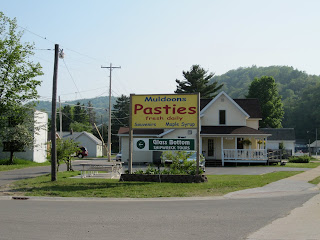Choosing a place to stay often depends on whether it’s en route to another destination, if we need to catch up on domestic things or visit tourist attractions. When an American Holiday is coming up such as Memorial Day, 4th July or Labor Day, we have to book well in advance because many places have been booked for a year and it’s hard to find somewhere at the last minute. That’s why we found Iron Mountain and “Summer Breeze Campground” in the Upper Peninsula of Michigan.
The owner, Carole, managed to find a site long enough for our vehicles, even though they were fully booked. Once we arrived, her husband, Jerry, asked if we’d like to check out the site in his golf-cart (that’s the usual mode of transport around campgrounds for the owners and workers). There wasn’t much room for three of us and no room at the back, so he said I’d probably have to sit on Howard’s lap and added “I’ll bet this is the most fun Howard’s had in some time!” Cheeky monkey - but it was funny.
 |
| Trillium in the woods |
We found a lovely wooded site but having inclement weather stayed on for a fifth night to let the storm pass.
We also took out three DVD’s from Family Video and couldn’t believe their special deal for being a new customer, only $1.00 for all three. One of the DVDs was “Saving Private Ryan” - what a perfect film for Memorial Day - the ending made me weep.
At the Welcome Center in Iron Mountain, we met a charming young girl called Lea, who was very happy to help us and gave us two large bagfuls of brochures, each for the Upper and Lower Peninsula. The two parts of the state are divided by the five mile long Mackinac Bridge dividing Lake Huron and Lake Michigan. I’d heard that people from the UP were called “Yoopers” so I asked her if that was true and if so was there a name for people in the Lower Peninsula. She said yes “they’re called Trolls because they live under the Bridge”. This was just hilarious and we thought it incredibly funny, but she did add that some people were offended by this, especially if they lived south of the Bridge. Really! It’s good for people to laugh at themselves sometimes. I usually laugh at my own jokes because no-one else does.
 |
| Muldoons in Munising, MI |
We ate lunch at a local restaurant called “Family Kitchen” and their Wisconsin cheese and potato soup was so good that we went back another day. They also made their own garlic bread - mmmmm.
We didn’t visit the Cornish Pump Museum or the Iron Mine but I now understand why the pasty (pronounced pastee) is so well known here because when the tin mines gave out in the west of England the miners from Cornwall arrived in the UP and made this particular hand-held meat and potato pie so popular that there are now specialized Pasty Shops. This one was in Munising, our next stop.















































